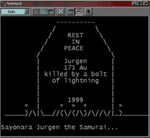|
The big art-development task is the monsters. NetHack has well over 100. Even assuming they are not animated when at rest or walking, we still need four to six frames of animation, facing in each of eight directions, for each monster's attack. Plus a death animation; we can probably get away with four directions for this (they might have to turn 45 degrees to die). Plus "sleeping" images, and two stages of corpse (fresh and decayed). We wind up with around 64 frames of animation for each. That probably takes a decent artist with access to 3D Studio Max or SoftImage a day or two to execute.
Characters are more difficult; there are a slew of character classes, two genders, and a wide variety of weapons and armor. We can't possibly do separate animations for all possible combinations. Instead, we'll need a bit of clever programming. We have separate animations for each character class/gender combination for a variety of actions (walking, fighting, kicking, etc.) in each of eight directions. We also have animations for armor as seen from eight directions. These are composited with the character in different layers. Weapons are, again, separate images or animations, also composited with the character; character animations are carefully designed so that the "hand" is always, in each frame of animation, at the appropriate position to hold the weapon. Difficult, but possible. Objects have graphical representations; some have several states (e.g., open and closed). So do spells. We'd need a fairly limited suite of sounds; various attacks, spell sounds, and the like. A substantial development task, all in all; even with the existing code base, I wouldn't want to do this for less than $500K in a commercial product.... Can open-source make it happen?
What's in it for the geeks? Well--what is it that keeps Linux from becoming a viable OS for home users? Per the infamous Halloween memoranda--which outline Microsoft's strategy to crush the open-source movement--part of Linux's problem is that it is not (yet) easy for non-hackers to install and configure. But a bigger problem is this: real people (as opposed to hackers) use computers for a limited number of tasks. They use it for world-processing and spreadsheets and other "office" tasks; Linux has programs to do this that are as good or better than Microsoft's. They use it for web-browsing; Netscape/Mozilla for Linux is as good or better than Internet Explorer. And they use it to play games. I'm not a hardcore hacker, but I love the open-source ethos; I'm tempted, at times, to install Linux on my home machine. But one thing stops me: if I did, I couldn't play games. (Not many games anyway; Doom and Quake have been ported to Linux, and a Linux version of Activision's Civilization: Call to Power will be available.) Linux has to become easier for non-hackers to use, if it is ever to move out of the server market and onto the desktop. But it also has to become a more viable platform for games. Inherently, the VisualHack development project would involve the creation of much of the infrastructure needed to make Linux a viable gaming platform. We'd need to build the tools to construct screen images, flip them for animation, handle flicker and other such artifacts. We'd need to build an abstraction layer that doesn't require the user to know the details of what drivers are getting called. We'd need to build the ability to mix sounds, save and restore gamestates, and so on and on.... We'd need, in short, to start making Linux a gaming platform. And the results could be evangelized to game developers. They're well aware of the dramatic growth in Linux's installed base, but they also know that the GUI situation is unsettled, and that most Linux machines are not on the desktop, even in work environments. Some developers--particularly Id and Bungie--are committed to cross-platform development; but they need some evidence that this can ever become a viable market. VisualHack could help provide that.
The grid bug zaps you! But it's an idea. Someone should try. Our current game development model sucks; it funnels a million me-too products down a tiny channel, and nobody but the publishers makes a dime. And often not them. Why not try to revolutionize the world's second-largest entertainment industry at the same time as the world of conventional software? Developers of the world unite. You have nothing to lose but your games. And you've lost them already, you twits; it's all work for hire, innit, pal?
|
